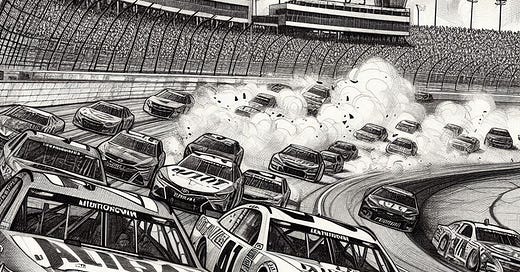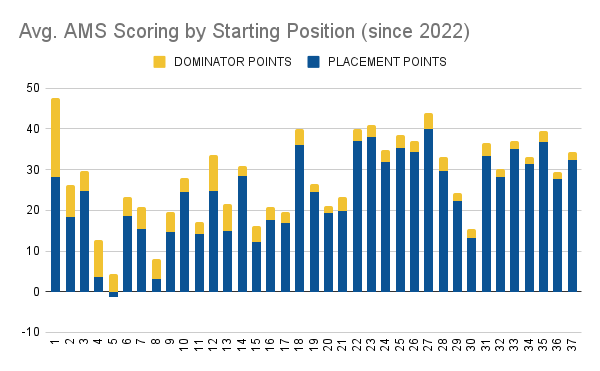Personally—I’m in love with the aberration that the Olympics forced onto the Cup Series schedule.
An all-out battle for playoff spots at one of the Series’ most treasured tracks? And a playoff opener at the new hotness, the third addition to the drafting track family? I’m a tiny bit bummed we’re not getting this same offering next year.
Best to enjoy it while we can. And despite the heartburn-inducing character of the on-track event, Atlanta is a super fun spot for DFS. Like Daytona, the start-to-finish pack racing forces DFS players (at least on DraftKings) to chuck dominator analysis out the window. Heck, even picking drivers is a smidge futile. There’s just too much chaos to make hunting down signal worth it.
This week’s note is going to take the same format as the Daytona piece from a couple of weeks back. No thesis, no dominators. Just discussion of lineup building strategies and a thumbs-up-thumbs-down list.1
Fantasy Situation Overview
Daytona’s reputation for insanity is well-established. Somehow, Harrison Burton winning at the track doesn’t even feel all that nuts. Atlanta’s only had a few events since the all-important repave, which caused a tectonic shift in how racing unfolds at the circuit. But even in that short period of time, AMS has produced enough madness to warrant recognition as a sister to the traditional superspeedway twins (Daytona and Talladega). Below is a the distribution of DraftKings scores at the track since the repave:
The hefty chunk of outcomes south of the zero marker is reminiscent of Daytona’s distribution. And the dearth of results north of 75 points recalls the same.
Madness is perhaps too strong of a word for Atlanta—for now. It hasn’t yet created a mind-boggling result, like Harrison Burton’s playoff ticket a couple of weeks ago. But the Cup Series has only visited the reborn track a handful of times. The racing is dicey from start to finish, and driver’s won’t know if they had a good day until the checkered flag waves. Eventually, something outlandish will unfold.
One important point of distinction between AMS and the traditional drafting tracks is its length. Atlanta is only 1.5 miles around.2 That means a full race distance entails a far greater number of laps than are found at Daytona or Talladega. For DFS purposes, that means that dominators do actually matter this week. I’m not going to spend time analyzing them because I don’t believe it’s the right way to think about building lineups this week. But the possibility that one driver leads nearly half the race and racks up a load of fastest laps needs to be in the back of players minds as they build lineups. Consider average fantasy scoring at AMS by starting position:
While the histogram chart showing all scores tells us a 100+ point day is technically feasible, the averages indicate there’s not a ton of edge to be found by picking out fast cars up front. Sure, someone might go off. And DFS players want to have an idea of who might do that, and ensure they’ve got healthy exposure to those drivers. But winning this week is going to be more about stacking up cars with placement point potential, potential generated by starting near the back. Of course, cars starting near the back are doing so for a reason. The reason is that they couldn’t keep up with most of the field in qualifying. So we know that there’s a chance the individual drivers we settle on really are just bad at AMS. But if we hit on the right combination of poor qualifiers, our lineup has the potential to score north of 350 points (typically an excellent score, especially if no one driver scores above 100).
Constructing a GPP Lineup
A couple of weeks ago, during the Daytona race weekend, I suggested a simple framework for picking out drivers:
We look for drivers who can a) finish well and b) can finish several places ahead of where they start.
That’s the case again this week. We’ll give a little more weight to the ability to finish well this week because—as noted above—a really strong car might go for 100+ points. But for the most part, we want our drivers to pass both tests with flying colors.
We also want to think about correlations this week. Drafting tracks traditionally force teams that share a manufacturer to work together. And that incentive is layered on top of the existing incentives teammates have to work as a unit. As such, “stacking” (rostering several of) drivers from the same teams or manufacturers creates the opportunity for a single event, like Ford picking the right strategy or having the best setup, to benefit all six of your roster spots.
So for this week, I want to examine a couple of stacking opportunities that I’ll be considering for my hand-built lineups.
Toyota
Toyota has a host of talented drivers starting reasonably deep in the field.
The most obvious member of the set is Denny Hamlin, starting in 38th. I’m not all that excited about rostering Hamlin this week, because his famous drafting track skills and starting spot will make him an auto-click for the majority of the field we’re playing against. I wouldn’t be surprised if Hamlin clears 50% ownership in GPPs this week. So if we’re playing him, we’re playing him as a blocker, a player we roster because so many other lineups have him and his success would lock us out of the prize pool.
I am hyped about the 23XI and Joe Gibbs Racing pilots hovering around 25th on the grid. While JGR’s drafting track ringer is Hamlin, we don’t need Christopher Bell ($8,300, starting 26th) or Martin Truex Jr. ($8,100, starting 22nd) to win the race. We just need a top five or top ten. The same goes for Tyler Reddick and Bubba Wallace. The betting markets suggest they each have about a 33-40% of pulling off a top ten finish. But as discussed above—those are correlated outcomes. If Toyota cars as a whole end up with an edge (maybe they handle better as the track evolves, or collectively avoid a big wreck because they bunch up around the same spot on the track), then everyone’s value jumps up pretty aggressively. As a unit, they’ve got the placement point potential and talent pedigree we’re looking for.
RFK Racing
This stacking option doesn’t extend to the whole collection of Ford teams. As a group, they’re starting very, very high up in the field. And while that means that including one or two Ford drivers with a history of success is probably the best way to capture any possibility of a 100+ point day, it also means that Fords as a class are very dangerous clicks for lineup builders. They have to cash the checks they wrote in qualifying to finish the day as good plays. Ryan Blaney at $10,500 is probably the best choice out of the group, despite the hefty price tag. He’s got a short path to the front, and drafting track wins on his resume.
But—this section is about RFK, not Ford as a whole.
The RFK drivers, Brad Keselowski ($10,300, starting 19th) and Chris Buescher ($9,000, starting 17th) are more expensive than the Toyota options we’ve already examined. The reason I think they’re a viable play this weekend is because they give DFS players a way to avoid rostering Denny Hamlin while still paying for expensive drivers.
Sometimes, it’s good to have expensive options. After all, given that this is a drafting track, cheap drivers like Justin Haley, Ricky Stenhouse Jr., and Corey LaJoie are viable. One big wreck, and those drivers could be looking at top 15 finishes. Ideally, you don’t leave loads of salary lying around. So, DFS players will spend that salary, and the most attractive expensive driver is Hamlin. But if large chunks of the field roster Hamlin, his value to each individual lineup decreases. To use an exaggerated example, if 100% of the field had Hamlin, even a 200+ point day would be utterly meaningless. When he’s rostered at 50% or higher, he’s only worth getting overweight on if we’re confident he’s likely to have the best day of the entire Cup Series grid. I don’t have that confidence.
Instead, I want a diversified portfolio with plenty of Keselowski and Buescher. I want a way to benefit if Hamlin wipes out in a big wreck that allows cheaper cars starting near the back to have their personal best weekend of the season. Drafting tracks have the ability to create those kind of outcomes, and DFS player’s lineup building process should respect that fact. This pick reflects the pair’s talent at drafting tracks, yes. But it’s predicated mostly on their value as diversifying pieces.
“Thumbs Up” and “Thumbs Down”
This is the section to glance at if you’re only building a couple of lineups this weekend. I don’t think that’s the way to play drafting tracks, but we can’t all crank out hundreds of driver combinations. Just be advised—anxiety is on deck if you’ve got all your eggs in one basket.
Thumbs Down:
Michael McDowell: No pole drivers at drafting tracks, please.
Austin Cindric: He needs a top five to return value this weekend. He’s flashed some of the potential that got him his Penske seat at various points this year. He needs to fulfil that promise to be a good play, and he’s broken that promise a lot over the last few years.
Austin Dillon: See Austin Cindric’s entry, with the added caveat that Richard Childress Racing has improved significantly in recent weeks. But probably not enough to justify paying for a mere eight place differential points.
Thumbs Up:
Chase Elliot: Starting in 16th, Elliot has a lot of place differential points on offer and an betting market implied probability of 13% to snag a top three. Now, those implied probabilities are a bit inflated, but the fact that Elliot has drafting track upside isn’t in dispute. His price tag ($9,500) also makes him an interesting pivot off of RFK Racing or Hamlin.
Joey Logano: I think it’s time for the small gains to add up to something big. Drafting tracks have a nasty habit of punishing drivers that start up near the front—and Logano is starting in 7th. But he’s also getting a lot of steam in betting markets, a useful proxy for upside. And, he’s an excellent pivot away from all of the other attractive options on the slate. It wouldn’t surprise me if Hamlin, Blaney, and the Toyota cluster tank Logano’s ownership, making him a valuable card to hold.
Assuming he doesn’t get wiped out or just have one of those awful days that’ve been plaguing him all season. It’s a possibility for sure. This is purely an ownership and upside play.
A Note About the Playoffs
I don’t take playoff eligibility into consideration all that much during these months. While it can affect how individual drivers race each others, the basic incentive structure that existed in May exists now. I feel that adjusting a forecast when that structure is unchanged is unwise. We’ll examine this position again when we head to Watkins Glen, as there’s a reason to think the incentives do switch. But at Atlanta, everyone wants to survive the chaos and hoist the trophy.
Final Thoughts
I think a healthy dose of insanity is an excellent way, from an entertainment perspective, to start these playoffs. Variance belongs at the start of a championship run, not the end. So make sometime in between football games to catch some of the action!
Happy watching!
Unless otherwise noted, all data in this article is drawn from Racing Reference: https://www.racing-reference.info/.
Typically, my decision rule would require me to treat Atlanta as an intermediate track. But the obviousness of AMS’s place among drafting tracks makes my decision rule pointless.






